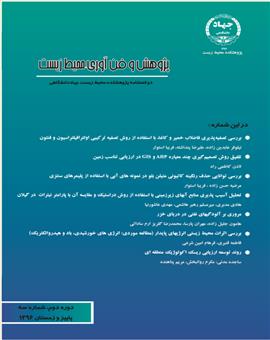تلفیق روش تصمیمگیری چند معیاره AHP و GIS در ارزیابی تناسب زمین
محورهای موضوعی : Urban and local planning
1 - دانشگاه علوم و تحقیقات
کلید واژه: ارزيابي زمينتناسب زمين فرآيند تحليل سلسله مراتبي توسعه كالبدي عوامل طبيعيسيستم اطلاعات جغرافيايي,
چکیده مقاله :
شناخت و تعيين تناسب و استعداد زمين براي توسعة كالبدي و شهري از اقدامات اوليه در برنامهريزيهاي فضايي و محيطي است. هدف از انجام پژوهش اين است كه با توجه به عوامل طبيعي، نواحي مناسب براي توسعة كالبدي در استان گیلان شناسايي و پراكنش فضايي آنها مشخص گردد. تعيين تناسب زمين از طريق هفت معيار طبيعي مشتمل بر شیب، ارتفاع، پوشش زمین، بارش، فاصله از گسل، جنس سنگ، تناسب خاک و روش فرآيند تحليل سلسله مراتبی (AHP) در محيط سيستم اطلاعات جغرافيايي صورت پذیرفت. تناسب زمين براي توسعة كالبدي به سه طبقة زياد، متوسط و كم تقسيم شد و نقشة پهنهبندي آن تهيه گرديد. نتايج نشان داد كه صرفنظر از مناطق حفاظت شده و محدوده تالاب، حدود 62 درصد از منطقه مورد مطالعه در طبقه با تناسب زیاد قرار گرفتهاند و با ملحوظ داشتن ساير پارامترها ميتوانند براي توسعة كالبدي مدنظر برنامهريزان و سياستگزاران قرار گيرند.
Recognizing and determining the suitability and talent of the earth is one of the primary measures in spatial and environmental planning for physical and urban development. The aim of this research is to identify and determine the spatial distribution of suitable areas for physical development in Guilan province. Land suitability was determined by hierarchical process analysis (AHP) method and using seven natural criteria including gradient, altitude, cover, rainfall, distance from fault, rock, soil. The land suitability for physical development was divided into three large, moderate and low classes, and its zoning map was prepared. The results showed that, regardless of the protected areas and the wetland, about 62% of the study area is located in the class with a high proportion. With the consideration of other parameters, these areas can be considered for developmental planning by planners and policy makers.
